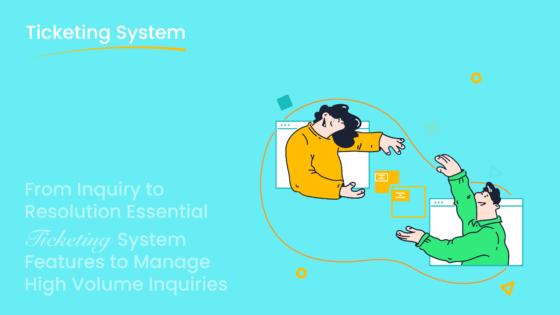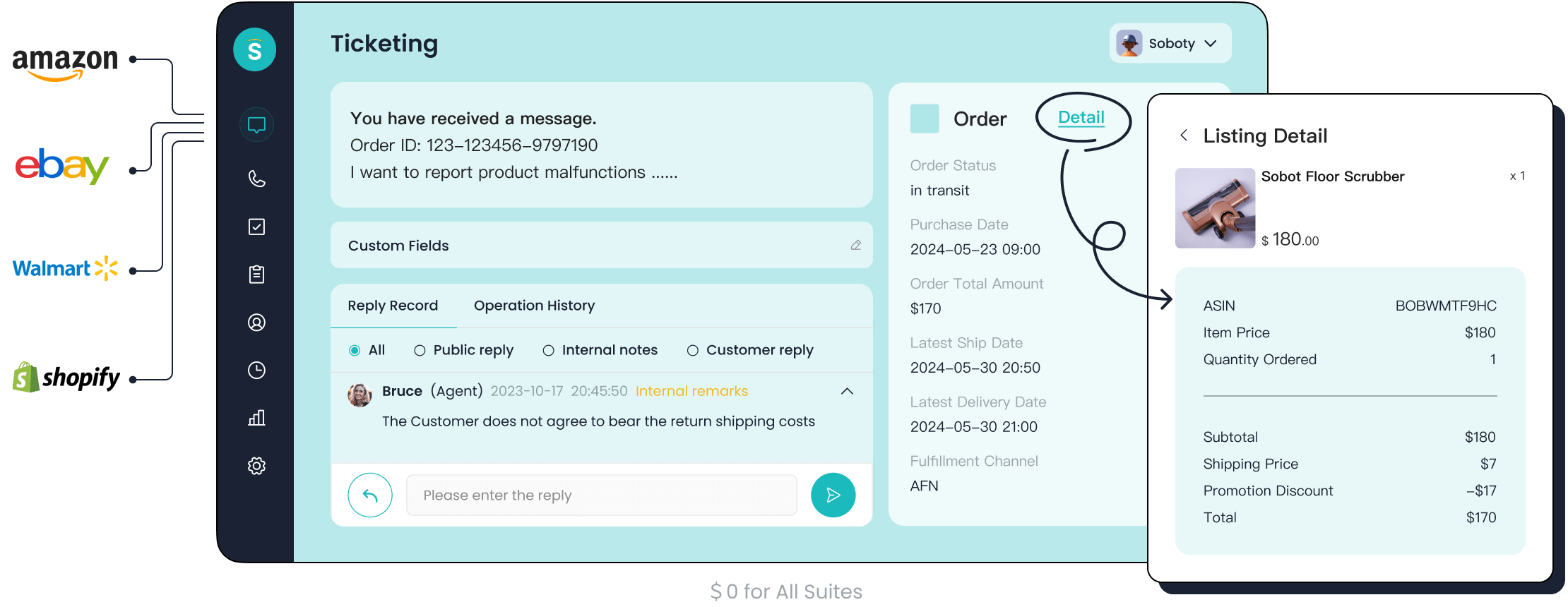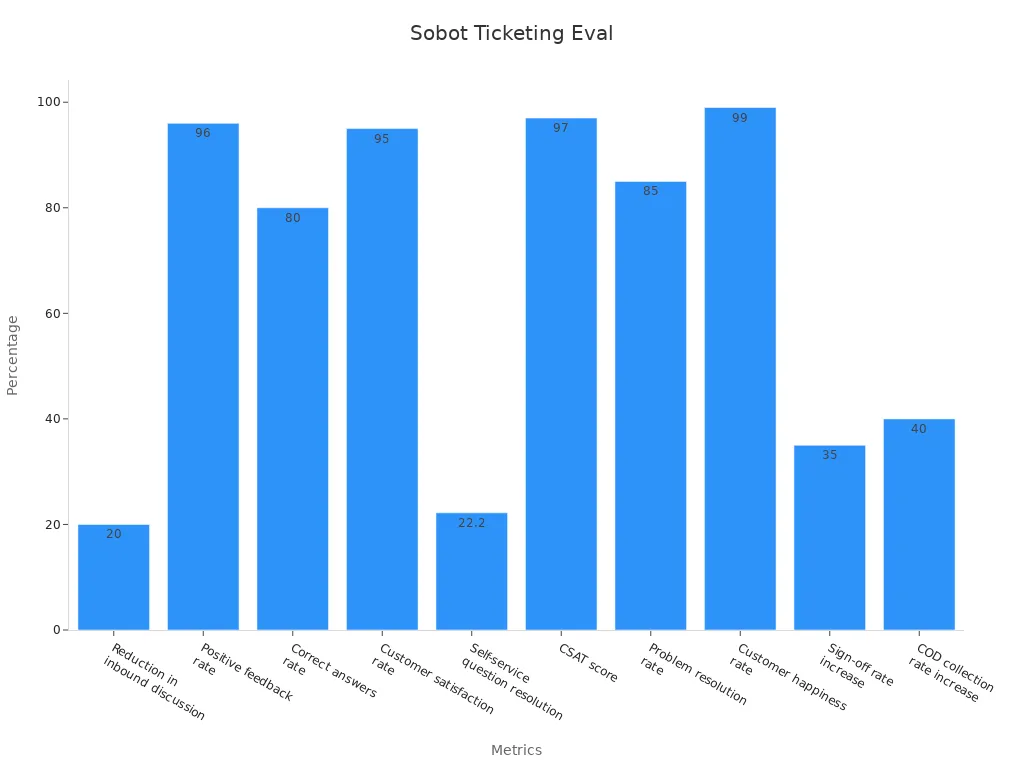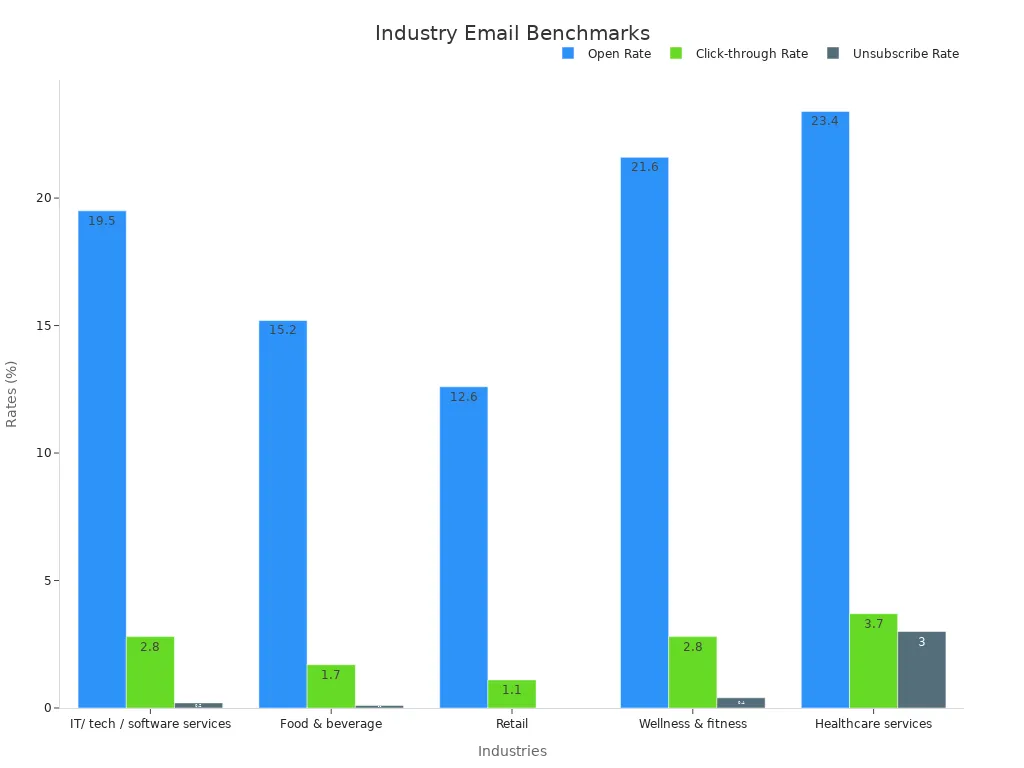Best Email Ticketing Platforms for Small Businesses

Managing customer inquiries through email can feel overwhelming, especially for small businesses. Did you know the average employee spends nearly three hours daily checking emails? With 124.5 billion work emails exchanged every day, staying on top of customer requests becomes a real challenge. That’s where an email ticketing system comes in. It helps you organize, prioritize, and respond to emails faster, improving your efficiency and customer satisfaction. Platforms like Sobot, Zendesk, Freshdesk, Help Scout, and Zoho Desk offer excellent solutions to streamline your support operations.
Why Small Businesses Need an Email Ticketing System

Streamlining Customer Support Operations
Running a small business often means juggling multiple tasks at once. When customer service gets chaotic, it can hurt your reputation. An email ticketing system helps you organize everything in one place. Instead of digging through endless email threads, you’ll have a clear view of every customer request. This makes it easier to prioritize and resolve issues.
Take V Bazaar, for example. They struggled with communication gaps across 16 departments, leading to unresolved issues and missed opportunities. After adopting a centralized ticketing system, they improved communication and resolved problems faster. Customers were happier, and no sales opportunities slipped through the cracks. That’s the power of streamlining your operations.
Enhancing Response Times and Efficiency
Quick responses can make or break your customer relationships. With ticketing systems, you can track and improve key metrics like response time and resolution speed. These systems automate repetitive tasks, so your team can focus on solving problems instead of managing emails.
Here’s a snapshot of how these metrics work:
| Metric | Description |
|---|---|
| First Response Time | The average time it takes for an agent to reply to a ticket. |
| Average Resolution Time | The total time taken to resolve a ticket, including back-and-forth communication. |
| Average Handle Time | The time an agent spends actively working on a ticket. |
| First Contact Resolution Rate | The percentage of tickets resolved in the first interaction, showing how efficient your support is. |
By improving these metrics, you’ll not only save time but also boost customer satisfaction.
Improving Team Collaboration and Workflow
When your team works together seamlessly, your customer service shines. Email ticketing systems create a shared workspace where everyone can see what’s happening. This reduces confusion and ensures no ticket gets overlooked. Features like automatic ticket assignment and status updates keep everyone on the same page.
Imagine your team handling a high volume of inquiries during a sale. Instead of scrambling, they’ll know exactly who’s handling what. This clarity improves efficiency and helps your team deliver top-notch service every time.
Key Features of the Best Email Ticketing Systems
Unified Communication Across Channels
Managing customer inquiries across multiple platforms can feel like a juggling act. That’s where unified communication comes in. The best email ticketing systems bring all your communication channels—like email, chat, and social media—into one platform. This makes it easier for you to manage and respond to customer requests without switching between tools.
Here’s how unified communication helps:
| Benefit | Description |
|---|---|
| Omnichannel Support | Lets you handle all communication channels from one place, ensuring a consistent experience. |
| Real-Time Communication | Enables instant responses to customer inquiries. |
| Enhanced Analytics | Provides insights into customer interactions and agent performance for better decision-making. |
| Improved Collaboration | Helps your team work together seamlessly to resolve issues faster. |
By consolidating everything, you’ll save time and deliver a better customer experience. Plus, it ensures your responses are consistent, no matter which channel your customers use.
Tip: Look for systems that offer multi-channel support and email integration. These features make ticket management much smoother.
Automation and SLA Management
Repetitive tasks can slow you down, but automation changes the game. The best systems automate ticket creation, routing, and even responses to common issues. This frees up your team to focus on more complex problems. They also include SLA (Service Level Agreement) management, which helps you set clear response and resolution times.
Here’s what automation and SLA management can achieve:
| Metric | Result |
|---|---|
| Support ticket deflection | 80% fewer tickets for agents to handle. |
| Time-to-resolution | Faster ticket resolution times. |
| Customer Satisfaction (CSAT) | 25% improvement in just three months. |
With these tools, you’ll not only improve efficiency but also boost customer satisfaction. Automation ensures nothing falls through the cracks, while SLA management keeps your team accountable.
Integration with Other Tools and Platforms
Your email ticketing system should work well with the tools you already use. Integration with other systems, like CRM or e-commerce platforms, makes ticket tracking and reporting seamless. For example, connecting your ticketing system with Shopify or Salesforce allows you to access customer data instantly. This helps you provide personalized support.
Here are some real-world examples of successful integrations:
| Company | Integration Use Case | Performance Data |
|---|---|---|
| Coca-Cola Company | Real-time conversations in 26 languages. | Engaged over a million people in 60 days. |
| Air India | Virtual assistant for customer queries. | Handled nearly 4 million queries, improving customer experience. |
| BMW Group | Connected users to vehicles via an app. | Supported 450 million daily requests. |
When your ticketing system supports integration with other systems, it simplifies workflows and enhances productivity. It’s a win-win for you and your customers.
Multilingual and Global Support Capabilities
Expanding your business globally means connecting with customers from different cultures and languages. If you want to build trust and loyalty, speaking your customers’ language is key. That’s where multilingual support in email ticketing systems comes into play. It ensures you can cater to a diverse audience without missing a beat.
Why does this matter? Let’s break it down:
- Improved Customer Satisfaction: Customers feel valued when you communicate in their language.
- Expanded Market Reach: Multilingual support opens doors to new regions.
- Increased Trust and Loyalty: People stick with brands that understand them.
- Higher Conversion Rates: Addressing concerns in a customer’s language can boost sales.
- Enhanced Brand Reputation: It shows professionalism and inclusivity.
- Reduced Miscommunication: Clear communication minimizes errors.
- Competitive Advantage: It sets you apart in global markets.
Modern systems even use AI to generate multilingual responses quickly. This not only speeds up ticket management but also ensures accuracy. For example, if a customer in Spain emails you in Spanish, your system can translate and respond in their language. It’s efficient and keeps your customers happy.
Pro Tip: Look for systems with built-in multilingual capabilities and email integration. These features make it easier to manage global customer inquiries.
Analytics and Reporting for Data-Driven Decisions
Data is your secret weapon for improving customer support. Email ticketing systems with robust analytics and reporting features help you track performance and make smarter decisions. They turn raw data into actionable insights, so you can refine your strategies.
Here’s how analytics can help:
- Informed Decision-Making: Use data to adjust your approach and improve outcomes.
- Predictive Insights: Analyze trends to anticipate future needs.
- Metrics and KPIs: Track key performance indicators to measure success.
For example, you can monitor metrics like customer retention rates or average resolution times. These numbers tell you what’s working and what needs improvement. Here’s a quick look at how different industries use analytics:
| Metric Type | Example Metrics | Impact on Decision-Making |
|---|---|---|
| E-commerce Metrics | Conversion rate, average order value, customer acquisition cost | Helps optimize marketing strategies and sales processes |
| Healthcare Metrics | Patient satisfaction scores, readmission rates, average length of stay | Improves patient care and operational efficiency |
| General Business Metrics | Revenue growth, customer retention rates | Informs strategic planning and resource allocation |
With these insights, you can fine-tune your ticket management processes and even improve it service management. Whether it’s resolving tickets faster or identifying bottlenecks, analytics give you the clarity you need to succeed.
Did You Know? Businesses that use analytics to guide decisions often see a 25% boost in customer satisfaction within months.
Top Email Ticketing Platforms for Small Businesses

Sobot Ticketing System
If you're looking for a powerful yet user-friendly email ticketing system, Sobot's Ticketing System is a standout choice. Designed to simplify customer service, it offers a unified platform to manage all communication channels, including email, voicemail, and chat. This means you can handle tickets from multiple sources without switching tools.
What sets Sobot apart is its automation capabilities. Tasks like ticket creation, routing, and SLA management are automated, saving you time and reducing errors. For instance, tickets are automatically assigned to the right agent based on custom rules, ensuring faster resolutions. Plus, its multilingual support makes it ideal for businesses with a global audience.
Here’s a quick look at how Sobot performs:
| Metric | Value |
|---|---|
| Reduction in inbound discussion | 20% |
| Positive feedback rate | 96%+ |
| Customer satisfaction rate | 95% |
| Problem resolution rate | 85% |
| Customer happiness rate | 99% |

Sobot also integrates seamlessly with platforms like Shopify, making it a great fit for e-commerce businesses. Its analytics tools provide actionable insights, helping you refine your customer service strategies. With Sobot, you’re not just managing tickets—you’re building better customer relationships.
Pro Tip: Sobot’s SLA reminders and canned responses can significantly improve your team’s efficiency.
Zendesk
Zendesk is another popular name in the world of helpdesk solutions. Known for its robust features, it’s a great option for businesses that need a scalable platform. Zendesk excels in providing omnichannel support, allowing you to manage tickets from email, social media, and more—all in one place.
One of Zendesk’s strengths is its ability to track key metrics. For example, it helps you monitor open rates, click-through rates, and unsubscribe rates across industries. Here’s a snapshot of how it performs:
| Industry | Open Rate | Click-through Rate | Unsubscribe Rate |
|---|---|---|---|
| IT/ tech / software services | 19.5% | 2.8% | 0.2% |
| Food & beverage | 15.2% | 1.7% | 0.1% |
| Retail | 12.6% | 1.1% | 0% |
| Wellness & fitness | 21.6% | 2.8% | 0.4% |
| Healthcare services | 23.4% | 3.7% | 3% |

Zendesk’s automation features, like ticket routing and SLA tracking, make it easier to manage high volumes of inquiries. It also integrates with popular tools like Salesforce, giving you a complete view of your customer interactions. If you’re looking for a cloud-based help desk software that scales with your business, Zendesk is worth considering.
Freshdesk
Freshdesk is a versatile helpdesk platform that’s perfect for small businesses. It simplifies ticket management by organizing all customer inquiries in one place. Whether it’s email, chat, or social media, Freshdesk ensures no ticket slips through the cracks.
What makes Freshdesk stand out is its focus on customer satisfaction. It tracks metrics like CSAT (Customer Satisfaction Rating) and ticket reopenings to help you understand what’s working and what’s not. Here’s why these metrics matter:
- Customer Satisfaction Rating (CSAT): Measures how happy customers are with your service.
- Impact of Agent Responses: Shows how the number of interactions affects satisfaction.
- Ticket Reopenings: Highlights unresolved issues that need attention.
- Response and Resolution Times: Faster times lead to happier customers.
Freshdesk also offers features like canned responses and automation, which save time and improve efficiency. Its integration capabilities with tools like Shopify make it a great choice for e-commerce businesses. If you’re searching for the best help desk software to enhance your customer service, Freshdesk is a solid option.
Did You Know? Businesses using Freshdesk often see a noticeable improvement in their customer support metrics within months.
Help Scout
Help Scout is a web-based help desk software that’s perfect for small businesses looking to simplify customer support. It’s designed to make managing tickets easy while keeping your team organized and efficient. If you’re tired of juggling emails and struggling to keep track of conversations, Help Scout might be the solution you need.
One of its standout features is the Shared Inbox, which creates a collaborative space for your team. Instead of forwarding emails or losing track of who’s handling what, everyone can see the status of tickets in real time. This transparency ensures no ticket gets overlooked and helps your team work together seamlessly.
Help Scout also excels in help desk reporting. It offers detailed reports that track key metrics like response times and resolution rates. These insights help you identify bottlenecks and improve your team’s performance. Plus, its email integration makes it easy to connect Help Scout with your existing email system. You won’t need to switch platforms to manage customer inquiries.
Here’s a quick look at some of its features:
| Feature | Description |
|---|---|
| Shared Inbox | A collaborative space for teams to manage customer conversations efficiently. |
| Help Desk Reporting | Offers various reports to track key metrics like response and resolution times. |
| Email Integration | Seamlessly integrates with existing email systems for streamlined communication. |
Help Scout’s simplicity and focus on collaboration make it one of the best help desk software options for small businesses. Whether you’re managing a handful of tickets or hundreds, it keeps everything organized and easy to handle.
Tip: Use Help Scout’s reporting tools to monitor your team’s performance and find areas for improvement. It’s a great way to boost efficiency and keep your customers happy.
Zoho Desk
Zoho Desk is a cloud-based help desk software that combines powerful features with affordability. If you’re searching for a cost-effective solution to manage tickets, Zoho Desk deserves your attention. It’s packed with tools that simplify customer support and help your team deliver faster resolutions.
One of its key strengths is multi-channel support, which lets you handle customer inquiries across email, chat, and social media—all from one platform. This feature ensures your customers get consistent service, no matter how they reach out. Zoho Desk also uses automation to streamline processes like ticket routing and response management. By reducing manual effort, your team can focus on solving complex issues.
Security is another area where Zoho Desk shines. It complies with GDPR regulations and offers role-based data sharing, so you can control who sees sensitive information. This makes it a reliable choice for businesses that prioritize data protection.
Zoho Desk integrates seamlessly with tools like Zoho CRM, QuickBooks, and Stripe. These integrations improve productivity by connecting your helpdesk with other systems you already use. Here’s a closer look at its features:
| Feature/Integration | Description |
|---|---|
| Multi-channel Support | Enables seamless interactions across various channels, enhancing customer experience. |
| Automation | Streamlines processes, reducing manual effort and increasing efficiency. |
| Data Protection | Complies with GDPR and offers role-based data sharing for enhanced security. |
| Integrations | Connects with various financial software like Zoho CRM, QuickBooks, and Stripe, improving productivity. |
Users often praise Zoho Desk for its competitive pricing. Many reviews highlight its cost-effectiveness, with users calling it the most affordable help desk software they’ve tested. If you’re running a small business, this combination of features and affordability makes Zoho Desk a smart choice.
Note: Zoho Desk’s automation tools can save your team hours of work each week. It’s a great way to boost efficiency without increasing costs.
Benefits of Using Email Ticketing Systems for Customer Support

Centralized Communication for Better Organization
Keeping track of customer inquiries can get messy when you’re juggling emails, chats, and social media messages. Email ticketing systems simplify this by centralizing all communication in one place. You’ll have a clear view of every interaction, making it easier to respond quickly and accurately.
Here’s how centralized communication helps:
- It provides a complete view of customer interactions, so you can address customer issues faster.
- It eliminates duplicate records, saving time and reducing errors.
- Teams can collaborate better with real-time access to shared data, improving customer service workflows.
Imagine having all your tickets organized in one platform. Your team won’t waste time searching for information or duplicating efforts. Instead, they’ll focus on resolving customer issues efficiently. This streamlined approach ensures customers feel valued and heard, boosting loyalty and satisfaction.
Tip: A centralized system doesn’t just help your team—it also makes customers feel like their concerns are a priority.
Enhanced Customer Experience and Satisfaction
Happy customers stick around. Email ticketing systems improve the customer experience by ensuring faster responses and personalized support. They track every ticket, so you can provide tailored solutions based on past interactions.
Here’s what the numbers say:
| Statistic | Source |
|---|---|
| 64% of companies with a customer-focused CEO are more profitable than their competitors. | Deloitte and Touche |
| Companies that earn $1 billion a year will see an average gain of $700 million within three years of investing in customer experience. | Qualtrics |
| Over 60% of customers believe the ability to resolve issues quickly is one of the most important aspects of a good customer service experience. | Zendesk |
When you resolve tickets quickly and efficiently, customers notice. They’ll appreciate the effort and reward you with loyalty. Plus, systems that automate routine tasks free up your team to focus on complex customer issues, making your service even better.
Did You Know? Companies with strong omnichannel strategies retain 89% of their customers compared to just 33% for weaker strategies.
Cost-Effective Solutions for Small Businesses
Running a small business means keeping an eye on costs. Email ticketing systems help you save money while improving support management. They reduce the need for extra staff by automating repetitive tasks like ticket routing and canned responses.
Here’s why they’re cost-effective:
- Faster ticket closures mean less operational strain.
- Lower handling times maximize agent productivity.
- Improved customer satisfaction reduces churn, saving you money in the long run.
By investing in a helpdesk system, you’ll streamline operations and enhance customer service without breaking the bank. It’s a smart way to grow your business while keeping costs under control.
Pro Tip: Look for systems with built-in automation and analytics. These features save time and help you make data-driven decisions.
Data Insights to Improve Support Strategies
Data is a game-changer when it comes to improving your support strategies. With the right insights, you can identify what’s working, what’s not, and how to make your customer service even better. Email ticketing systems provide you with a treasure trove of data that helps you fine-tune your approach.
Here’s how these systems empower you with actionable insights:
- Comprehensive Metrics: Track response times, resolution rates, and customer satisfaction scores. These metrics highlight areas where your team excels and where they need improvement.
- Performance Evaluation: Use integrated reporting to evaluate individual agent performance. This helps you recognize top performers and guide others toward professional growth.
- Trend Analysis: Spot recurring issues and predict customer behavior. This allows you to take proactive steps to address problems before they escalate.
Imagine having access to detailed customer profiles. These profiles let you tailor your services to meet specific needs. For example, knowing a customer’s history helps you resolve their concerns faster and more accurately. It’s like having a cheat sheet for delivering exceptional service.
Key performance indicators (KPIs) also play a vital role. Metrics like customer satisfaction scores and retention rates measure how effective your support strategies are. By analyzing these numbers, you can make data-driven decisions that enhance the overall customer experience.
Pro Tip: Regularly review your analytics to stay ahead of trends. This keeps your support strategies fresh and aligned with customer expectations.
When you leverage data effectively, you’re not just solving problems—you’re building stronger relationships with your customers.
How to Choose the Right Email Ticketing System
Assessing Your Business Needs and Goals
Choosing the right helpdesk system starts with understanding your business needs. What problems are you trying to solve? Are you looking to improve response times, streamline ticket management, or enhance customer service? Defining your goals helps you focus on solutions that align with your priorities.
Here’s a simple framework to guide you:
| Step/Criteria | Description |
|---|---|
| Define Requirements | Identify the features you need, like automation or multilingual support. |
| Research Options | Compare helpdesk tools by reading reviews and vendor comparisons. |
| Create a Shortlist | Narrow down options that best match your needs. |
| Request Demos/Trials | Test usability and functionality firsthand. |
| Gather Feedback | Involve your team to evaluate the software’s effectiveness. |
| Make a Decision | Analyze costs, feedback, and features to choose the best fit. |
By following these steps, you’ll ensure the system you pick meets your unique needs and improves your customer support.
Testing Features with Free Trials or Demos
Free trials and demos are your best friends when evaluating helpdesk platforms. They let you explore features, test usability, and see how well the system handles tickets. A trial period also helps you identify potential challenges before committing.
Here’s why trials and demos work so well:
| Strategy | Effectiveness | Notes |
|---|---|---|
| Free Trials | Boost conversion rates by letting you test the platform with real scenarios. | Ensure the onboarding process is smooth for better results. |
| Product Demos | Highlight key features and use cases. | Live demos are more effective for understanding complex tools. |
| Hybrid Approach | Combines trials and demos for a deeper understanding. | Helps you reach the “AHA” moment faster, especially for complex systems. |
During the trial, involve your team. Their feedback will give you a clearer picture of how the system fits into your workflow. Look for features like automation, ticket routing, and integration with your existing tools. These can make a big difference in improving your customer service.
Evaluating Long-Term Costs and Scalability
Think beyond the initial price tag. A good helpdesk system should grow with your business. Look for platforms that offer flexibility in agent seats, handle increasing ticket volumes, and maintain high performance under heavy loads. Scalability ensures you won’t outgrow the system as your business expands.
Here are some key considerations for long-term success:
- Flexibility in agent seats lets you adjust as your team grows or shrinks.
- Efficient data storage ensures the system can handle more tickets without slowing down.
- Support for concurrent users keeps performance smooth during peak times.
- Automated workflow expansion streamlines operations as your needs evolve.
A scalable system saves you from switching platforms later, which can disrupt your customer service. It’s an investment in your business’s future growth and customer experience.
Reading Reviews and Case Studies for Insights
When choosing an email ticketing system, reviews and case studies can be your secret weapon. They give you a peek into how the platform performs in real-world scenarios. You’ll learn what works, what doesn’t, and whether it’s the right fit for your business.
Start with customer reviews. These often highlight the strengths and weaknesses of a platform. Look for feedback on ease of use, reliability, and how well the system handles customer support. Sites like G2, Capterra, and Trustpilot are great places to find honest opinions. Pay attention to recurring themes in the reviews. If multiple users praise a feature or complain about a limitation, it’s worth noting.
Case studies take things a step further. They show how businesses like yours have used the system to solve problems. For example, OPPO’s story with Sobot demonstrates how integrating a ticketing system can boost efficiency and customer satisfaction. OPPO achieved an 83% chatbot resolution rate and a 94% positive feedback rate. These numbers prove the impact of a well-implemented system.
Here’s a quick tip: Create a checklist while reading reviews and case studies. Include points like system reliability, automation features, and scalability. Compare these against your business needs. This approach helps you make a confident decision.
Pro Tip: Don’t just focus on the positives. Look for challenges other users faced and see if they align with your concerns. This ensures you’re prepared for potential hurdles.
By diving into reviews and case studies, you’ll gain valuable insights that guide you toward the best solution for your business.
An email ticketing system is more than just a tool—it’s a game-changer for small businesses. It helps you organize customer inquiries, respond faster, and improve satisfaction. The numbers speak for themselves:
| Statistic | Impact on Customer Support |
|---|---|
| Customer Satisfaction (CSAT) | Improved through faster responses |
| First Contact Resolution (FCR) | Increased due to AI handling L1 queries |
| Net Promoter Score (NPS) | Enhanced by quicker resolutions |
| Customer Retention | Boosted as CSAT and NPS rise |
| Lifetime Value of Customers | Increased profitability for the business |
| Essentialist CSAT Rating | Achieved a 97% rating with new system |
Among the top platforms, Sobot stands out as a comprehensive solution. Its global reach, intelligent task assignment, and seamless CRM integration make it a perfect fit for businesses aiming to streamline operations. Other platforms like Zendesk, Freshdesk, Help Scout, and Zoho Desk also offer excellent features tailored to different needs.
Take the time to evaluate your goals and explore these platforms. The right system can transform your customer support and set your business up for long-term success.
FAQ
What is an email ticketing system, and how does it work?
An email ticketing system organizes customer inquiries into tickets. It tracks, prioritizes, and assigns them to your team. Instead of managing scattered emails, you’ll have a centralized platform to streamline responses and improve efficiency.
Tip: Think of it as your digital assistant for managing customer support emails.
Can small businesses afford email ticketing systems?
Absolutely! Many platforms, like Sobot and Zoho Desk, offer affordable plans tailored for small businesses. These systems save time and reduce costs by automating repetitive tasks, making them a cost-effective investment.
How do email ticketing systems improve customer satisfaction?
They ensure faster responses, personalized support, and consistent communication. Features like automation and SLA tracking help you resolve issues quickly, leaving customers happy and loyal.
Do email ticketing systems support multiple languages?
Yes, most modern systems, including Sobot, offer multilingual support. This feature allows you to communicate with customers in their preferred language, making it easier to expand globally and build trust.
Can I integrate an email ticketing system with other tools?
Definitely! Many systems integrate with CRMs, e-commerce platforms, and communication tools. For example, Sobot connects seamlessly with Shopify and Salesforce, giving you a complete view of customer interactions.
Pro Tip: Check for integrations that match your existing tools to simplify workflows.
See Also
Best Live Chat Solutions for Small Enterprises in 2024
Ten Excellent Chat Tools for Businesses in 2024
Ten Leading Live Chat Solutions: Shopify and Rivals
